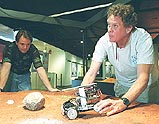By Will Hoover
Advertiser Staff Writer
In four words Bishop Museum Project Manager Kevin Johnson summed up the scope of the newest exhibit at the Castle Building, "X-treme Science! Exploring Oceans, Volcanoes & Outer Space," touted as the largest exhibit ever developed at the Bishop Museum.
 |
| Richard Duggan of Dare Designs assists at a display at Bishop Museum as museum volcanologist Kevin Johnson looks on.
Cory Lum • The Honolulu Advertiser |
"It’s bigger than ‘Sue,’" said Johnson.
Johnson was referring to the colossal "T. rex Named Sue" dinosaur skeleton road show that opened at the museum last July.
"That whole thing didn’t cover two stories. This exhibit covers the entire two floors of the building."
The purpose of the NASA-funded, hands-on "X-treme Science" exhibit is to highlight the kinds of scientific exploration that are unique to the Islands.
"People come here from all over the world to study oceans, volcanoes and outer space," said Johnson. "That’s why we chose those subjects. There’s a great breadth of research in each of those areas that’s going on here in Hawai‘i."
The ground floor exhibit covers Oceans and Volcanoes. Arriving visitors encounter a full-size interior mock-up of the Pisces submersible which has been used to explore Lo‘ihi, a 10,000-year-old volcanic crater located 3,000 feet below the ocean 21 miles south of the Big Island of Hawai‘i.
"It will look and simulate the Pisces, although it won’t be quite as cramped," said Johnson, checking out the mock-up. "There are portholes and two robotic arms that visitors can use to manipulate and pick up objects that are supposedly on the ocean floor."
The Volcanoes Room features more lava than probably has ever been allowed indoors, every bit of it way cool and simulated (though deceptively genuine-looking). Among other things, visitors can walk across an active lava flow with no fear of scorching their tootsies.
Up one flight of stairs visitors enter Outer Space. The exhibit’s third component features actual space meteorites, a 3-D panorama of the surface of Mars that was taken by the Pathfinder rover, and a scale model of the Martian rover that can be maneuvered across a simulated Red Planet terrain via remote control.
"You actually have a minute to see what you can find," said Richard Duggan, museum exhibits department chairman, as he attempted to maneuver the rover up a steep Martian grade. "When you get in certain areas you can scan the soil for water or sulphur or alien elements."
Although the focus of the exhibit is exploration, a secondary component is the people involved in the scientific community who are working in Hawai‘i.
Throughout the exhibit, interactive profile panels present video interviews with more than two dozen X-treme scientific types. Visitors can even ask them ask them specific touch-screen questions.
"We didn’t just chose people doing Ph.D research, we chose technicians, computer programmers and other people who are instrumental in scientific study," said Johnson. "What we wanted to do was to illustrate how science is important on all levels."
[back to top] |

 The Great Index to Fun
The Great Index to Fun